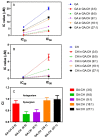Synergistic Inhibiting Effect of Phytochemicals in Rheum palmatum on Tyrosinase Based on Metabolomics and Isobologram Analyses
- PMID: 36770612
- PMCID: PMC9919157
- DOI: 10.3390/molecules28030944
Synergistic Inhibiting Effect of Phytochemicals in Rheum palmatum on Tyrosinase Based on Metabolomics and Isobologram Analyses
Abstract
Tyrosinase (TYR) plays a key role in the enzymatic reaction that is responsible for a range of unwanted discoloration effects, such as food browning and skin hyperpigmentation. TYR inhibitors could, therefore, be candidates for skin care products that aim to repair pigmentation problems. In this study, we used a metabolomics approach combined with the isobologram analysis to identify anti-TYR compounds within natural resources, and evaluate their possible synergism with each other. Rheum palmatum was determined to be a model plant for observing the effect, of which seven extracts with diverse phytochemicals were prepared by way of pressurized solvent extraction. Each Rheum palmatum extract (RPE) was profiled using nuclear magnetic resonance spectroscopy and its activity of tyrosinase inhibition was evaluated. According to the orthogonal partial least square analysis used to correlate phytochemicals in RPE with the corresponding activity, the goodness of fit of the model (R2 = 0.838) and its predictive ability (Q2 = 0.711) were high. Gallic acid and catechin were identified as the active compounds most relevant to the anti-TYR effect of RPE. Subsequently, the activity of gallic acid and catechin were evaluated individually, and when combined in various ratios by using isobologram analysis. The results showed that gallic acid and catechin in the molar ratios of 9:5 and 9:1 exhibited a synergistic inhibition on TYR, with a combination index lower than 0.77, suggesting that certain combinations of these compounds may prove effective for use in cosmetic, pharmaceutical, and food industries.
Keywords: Rheum palmatum; catechin; gallic acid; isobologram analysis; metabolomics; orthogonal partial least square-modelling; synergistic effect; tyrosinase inhibitory activity.
Conflict of interest statement
The authors declare no conflict of interest.
Figures





Similar articles
-
[Rapid analysis on phenolic compounds in Rheum palmatum based on UPLC-Q-TOF/MSE combined with diagnostic ions filter].Zhongguo Zhong Yao Za Zhi. 2017 May;42(10):1922-1931. doi: 10.19540/j.cnki.cjcmm.20170317.001. Zhongguo Zhong Yao Za Zhi. 2017. PMID: 29090552 Chinese.
-
A novel high-resolution monophenolase/diphenolase/radical scavenging profiling for the rapid screening of natural whitening candidates from Peaonia lactiflora root and their mechanism study with molecular docking.J Ethnopharmacol. 2022 Jan 10;282:114607. doi: 10.1016/j.jep.2021.114607. Epub 2021 Sep 8. J Ethnopharmacol. 2022. PMID: 34506940
-
[Comparison of gallic acid and catechin contents in five processed products of Rheum palametum].Zhongguo Zhong Yao Za Zhi. 2010 Sep;35(17):2267-9. Zhongguo Zhong Yao Za Zhi. 2010. PMID: 21137334 Chinese.
-
Valorization of biomass polyphenols as potential tyrosinase inhibitors.Drug Discov Today. 2024 Jan;29(1):103843. doi: 10.1016/j.drudis.2023.103843. Epub 2023 Nov 23. Drug Discov Today. 2024. PMID: 38000718 Review.
-
THE USE OF RHEUM PALMATUM L. IN THE TREATMENT OF ACUTE RESPIRATORY DISTRESS SYNDROME: A META-ANALYSIS OF RANDOMIZED, CONTROLLED TRIALS.Afr J Tradit Complement Altern Med. 2017 Jan 13;14(2):334-347. doi: 10.21010/ajtcam.v14i2.35. eCollection 2017. Afr J Tradit Complement Altern Med. 2017. PMID: 28573250 Free PMC article.
Cited by
-
HPTLC Combined with sHetCA and Multivariate Statistics for the Detection of Bioactive Compounds in Complex Mixtures.Molecules. 2024 Dec 20;29(24):6027. doi: 10.3390/molecules29246027. Molecules. 2024. PMID: 39770114 Free PMC article.
-
Pharmacokinetics-Pharmacodynamics Modeling for Evaluating Drug-Drug Interactions in Polypharmacy: Development and Challenges.Clin Pharmacokinet. 2024 Jul;63(7):919-944. doi: 10.1007/s40262-024-01391-2. Epub 2024 Jun 18. Clin Pharmacokinet. 2024. PMID: 38888813 Review.
-
Can NMR-HetCA be a Reliable Prediction Tool for the Direct Identification of Bioactive Substances in Complex Mixtures?Anal Chem. 2024 Dec 17;96(50):20090-20097. doi: 10.1021/acs.analchem.4c05080. Epub 2024 Dec 6. Anal Chem. 2024. PMID: 39642173 Free PMC article.
-
Plant Extracts as Skin Care and Therapeutic Agents.Int J Mol Sci. 2023 Oct 22;24(20):15444. doi: 10.3390/ijms242015444. Int J Mol Sci. 2023. PMID: 37895122 Free PMC article. Review.
References
-
- Goldman A., Goldust M., Wollina U. Periorbital hyperpigmentation—Dark circles under the eyes; treatment suggestions and combining procedures. Cosmetics. 2021;8:26. doi: 10.3390/cosmetics8020026. - DOI
-
- Deng Y., Huang L., Zhang C., Xi P., Cheng J., Wang X., Liu L. Skin-care functions of peptides prepared from Chinese quince seed protein: Sequences analysis, tyrosinase inhibition and molecular docking study. Ind. Crops Prod. 2020;148:112331. doi: 10.1016/j.indcrop.2020.112331. - DOI
-
- Xie P., Huang L., Zhang C., Ding S., Deng Y., Wang X. Skin-care effects of dandelion leaf extract and stem extract: Antioxidant properties, tyrosinase inhibitory and molecular docking simulations. Ind. Crops Prod. 2018;111:238–246. doi: 10.1016/j.indcrop.2017.10.017. - DOI
MeSH terms
Substances
Grants and funding
LinkOut - more resources
Full Text Sources

